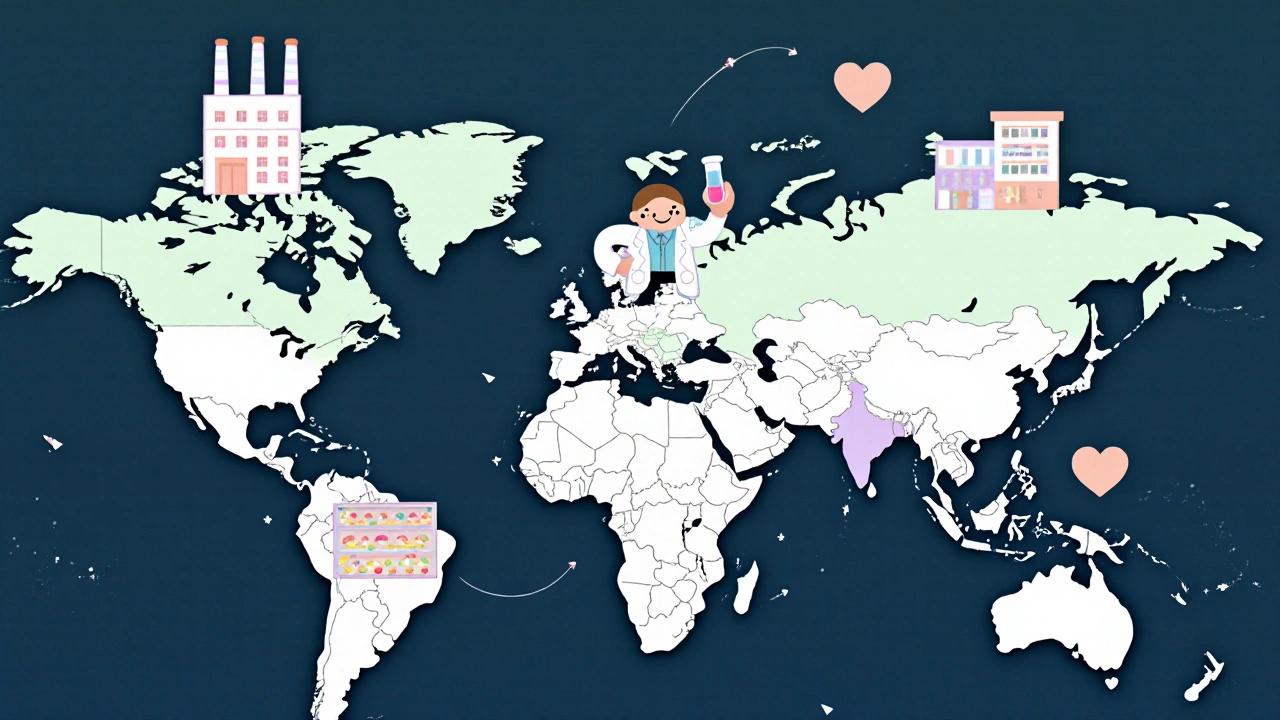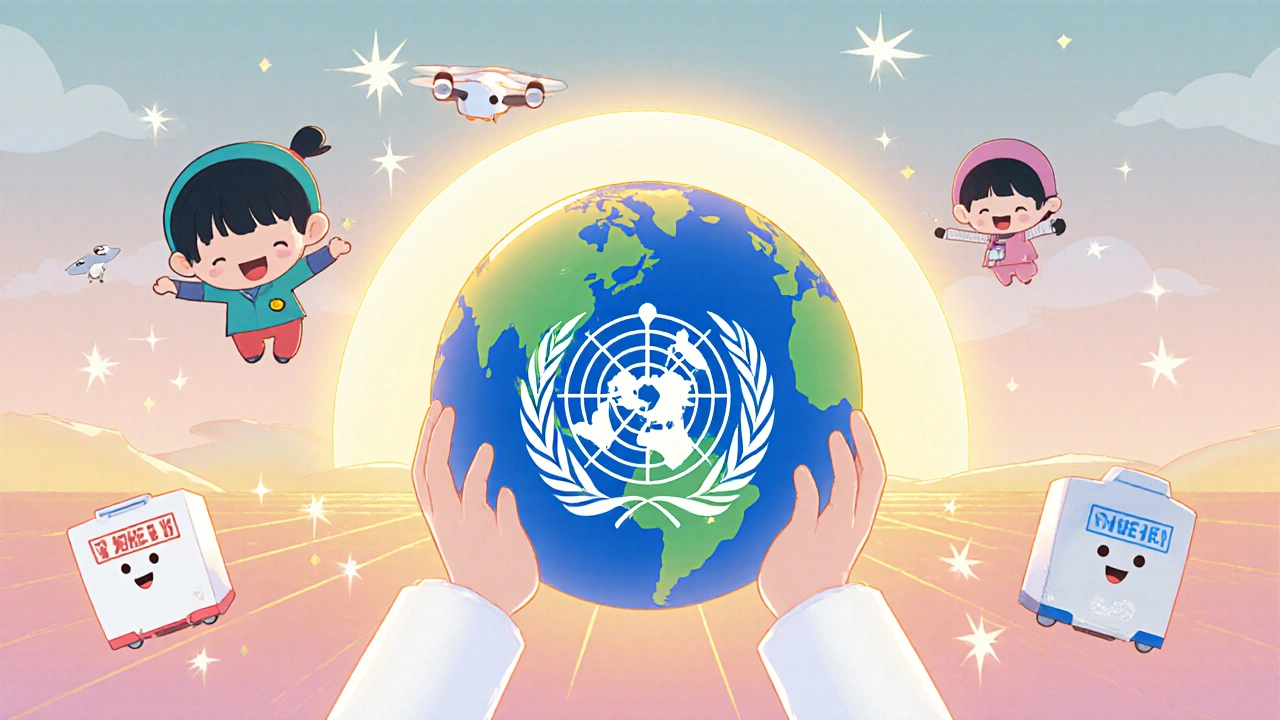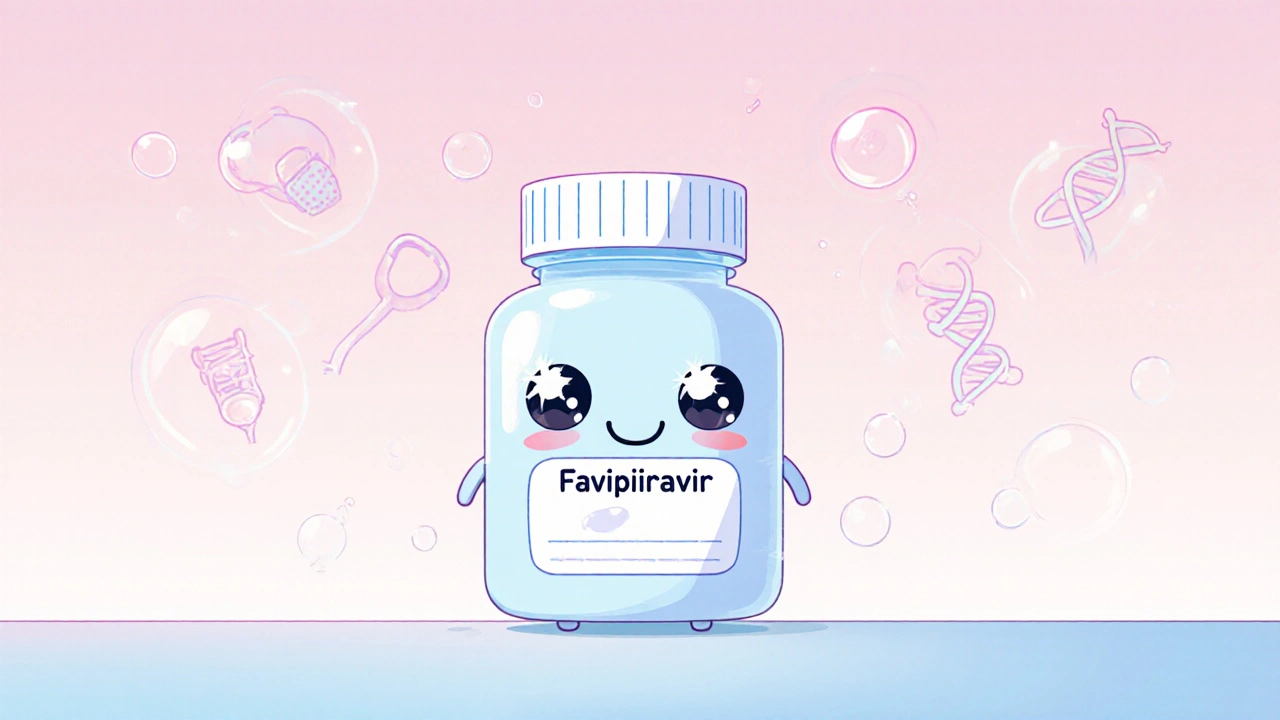Favipiravir Access & Pricing Calculator
When you hear about Favipiravir-the antiviral that surged onto the scene during the COVID‑19 crisis-you probably wonder: can I actually get my hands on it, and where?
What is Favipiravir?
Favipiravir, marketed under names like Avigan, is a synthetic RNA‑dependent RNA polymerase inhibitor. It was originally developed in Japan to treat influenza, but its broad‑spectrum activity made it a candidate for Ebola, Lassa fever, and most recently COVID‑19. The drug works by poking holes in the virus’s replication machinery, slowing the spread of infection inside the body.
Regulatory Landscape Around the World
Regulators treat Favipiravir like any other prescription medicine: they evaluate safety, efficacy, and manufacturing quality before granting a licence. Here’s the quick rundown as of October2025:
- Japan (PMDA) - First to approve Favipiravir in 2014 for novel influenza. The drug remains on the market under a standard prescription.
- China (NMPA) - Granted emergency use authorisation during the 2020 COVID‑19 wave and later full approval for mild‑to‑moderate cases.
- India (CDSCO) - Approved for COVID‑19 under a restricted‑use licence in 2021; many domestic manufacturers produce generic versions.
- European Union (EMA) - Still classifies Favipiravir as an investigational medicinal product; it is available only within clinical trials.
- United States (FDA) - Has not approved Favipiravir for any indication, but allows it under IND (Investigational New Drug) protocols for research.
- Brazil (ANVISA) - Holds a compassionate‑use programme that supplies the drug to hospitals treating severe viral outbreaks.
These differing rulings shape how the drug moves across borders, influencing everything from import licences to price tags.
Main Manufacturing Hubs
The bulk of the global supply originates from three regions:
- Japan - Fujifilm Toyama Chemical remains the original producer, churning out high‑purity batches for domestic use and export.
- China - Companies such as CSPC and Zhejiang Hisun have scaled up capacity, especially after the pandemic heightened demand.
- India - Generic factories like Glenmark and Cipla leverage cost‑effective processes, making the drug affordable for low‑income markets.
Turkey, Russia, and South Korea also run smaller lines, often feeding regional distribution networks.
Supply‑Chain Bottlenecks
Even with multiple manufacturers, getting Favipiravir from a plant to a patient isn’t always smooth. Key friction points include:
- Raw‑material scarcity - The active pharmaceutical ingredient (API) relies on a specific pyridine derivative that China sources heavily. Any export restriction spikes global prices.
- Patent‑related hurdles - While Japan’s original patents expired in 2023, some countries still enforce three‑year exclusivity extensions for “new uses,” limiting generic entry.
- Cold‑chain requirements - Favipiravir tablets are stable at room temperature, but certain formulations (injectable) need refrigerated transport, adding logistics cost.
- Regulatory paperwork - Import licences, batch‑release certificates, and quality‑control audits can delay shipments by weeks.

Regional Availability in 2025
| Region | Approval Status | Main Manufacturer(s) | Typical Price (USD per 10‑day course) | Availability |
|---|---|---|---|---|
| East Asia (Japan, South Korea) | Full approval | Fujifilm Toyama, Yuhan Corp. | $150‑$200 | Pharmacy via prescription |
| South‑East Asia (India, Bangladesh) | Restricted licence | Glenmark, Cipla | $30‑$50 | Government‑run distribution, hospital formulary |
| China | Full approval (COVID‑19) | CSPC, Hisun | $80‑$120 | Pharmacy, community health centres |
| Europe (EU) | Investigational only | None (clinical‑trial supply) | N/A | Only within approved trials |
| North America (USA, Canada) | IND/clinical‑trial | Import‑only, occasional compassionate‑use | $200‑$300 (clinical‑trial cost) | Research hospitals, specialty clinics |
| Latin America (Brazil, Mexico) | Compassionate‑use (Brazil) / Unregistered (Mexico) | Imported from India/China | $70‑$110 | Limited to public hospitals (Brazil) |
| Africa (South Africa, Kenya) | Not registered | None | N/A | Rarely accessed via WHO‑prequalified donation programmes |
Seeing the numbers, it’s clear that Favipiravir distribution is uneven. High‑income markets enjoy stable supply and insurance coverage, while low‑income regions depend on donations or clinical‑trial enrolment.
Pricing, Insurance, and Out‑of‑Pocket Costs
Price variation stems from three factors: manufacturing cost, regulatory fees, and local market dynamics. In India, bulk‑production keeps the course under $40, making it accessible through government health schemes. In contrast, the United States treats the drug as an experimental product, so patients often face trial‑related fees that can exceed $300.
Insurance coverage is another wild card. Countries with universal health systems (Japan, South Korea) reimburse the drug similarly to other antivirals. The U.S. Medicare and private insurers rarely cover investigational agents, leaving patients to seek enrollment in a study or apply for compassionate‑use exemptions.
How to Access Favipiravir in Different Settings
If you’re reading this because you need the medication, here’s a quick cheat‑sheet for the most common pathways:
- Prescription in approved markets - In Japan, South Korea, and China, ask your doctor for a standard prescription. The pharmacy will dispense the tablet pack.
- Government programme - In India and Brazil, the health ministry runs a limited‑supply programme. You’ll need a referral from a public‑sector physician.
- Clinical trial enrolment - For Europe and North America, look up ongoing trials on ClinicalTrials.gov or the EU Clinical Trials Register. Participation usually covers the drug cost.
- Compassionate‑use request - If you have a severe viral infection and live in a non‑approved country, your treating physician can submit a request to the national regulator (e.g., FDA IND‑request). Approval times vary from a few days to several weeks.
- International donation programmes - The World Health Organization occasionally pre‑qualifies generic batches for low‑resource settings. NGOs partner with ministries to distribute the drug during outbreaks.
Remember, self‑medicating without a prescription can be dangerous. Favipiravir interacts with some anticoagulants and can raise uric acid levels, so medical supervision matters.

Future Outlook - 2026 and Beyond
Looking ahead, a few trends could reshape the accessibility picture:
- WHO prequalification - If the WHO grants prequalification status to a generic Indian product, many UN‑funded procurement agencies will be able to buy at bulk rates, opening doors for lower‑income nations.
- New formulations - A dispersible tablet and inhaled powder are in phase‑II trials, promising easier dosing for pediatric and critically ill patients.
- Patent expirations - The remaining composition‑of‑matter patents in Europe are set to lapse in 2027, which could trigger a wave of generic approvals.
- Supply‑chain diversification - Companies are investing in API plants outside of China, reducing the risk of export bans.
All of this means the global map could look radically different in just a couple of years. Keeping an eye on regulatory announcements and WHO bulletins will pay off if you need the drug.
Quick Takeaways
- Favipiravir is fully approved only in Japan, China, and India (restricted).
- Prices range from $30 in India to $300 in the U.S. clinical‑trial setting.
- Access routes include prescriptions, government programmes, trial enrolment, compassionate‑use requests, and WHO‑run donations.
- Supply‑chain bottlenecks revolve around API scarcity and regulatory paperwork.
- Upcoming WHO prequalification and patent expirations could improve affordability worldwide.
Frequently Asked Questions
Is Favipiravir available over the counter?
No. In all countries where it is approved, Favipiravir is a prescription‑only medication. Even in places with compassionate‑use programmes, a doctor’s authorization is required.
Can I import Favipiravir for personal use?
Import rules differ by nation. The U.S. generally prohibits personal import of unapproved drugs unless you have an IND. EU citizens can import for personal use if the drug is part of a clinical trial, but a customs declaration is still required.
What side effects should I watch for?
Common issues include elevated uric acid, mild liver enzyme changes, and occasional diarrhea. Rarely, it can cause QT‑interval prolongation, so doctors usually check ECGs for high‑risk patients.
Is Favipiravir effective against COVID‑19 variants?
Laboratory data suggest the drug retains activity against most Omicron sub‑lineages, but real‑world effectiveness varies. Most health agencies now recommend it only for mild cases when other antivirals aren’t available.
Where can I find the latest WHO guidance?
Visit the WHO website’s “Therapeutics” section or check the WHO International Drug Monitoring Programme updates. They post PDF bulletins each quarter.

 Oct, 17 2025
Oct, 17 2025

Russell Abelido
October 17, 2025 AT 13:42Wow, reading about Favipiravir’s tangled supply chain really hits home-so many lives depend on those tiny tablets. I can’t help but feel a pang of hope when I see countries like India making it affordable. At the same time, the bottlenecks in raw‑material sourcing feel like a storm looming on the horizon. It’s a reminder that global health isn’t just science; it’s compassion in action. Hang in there, everyone 😊
Steve Holmes
October 21, 2025 AT 01:02Totally agree with you, Russell-this whole situation is a perfect case study, and the data you laid out is spot‑on! It shows how regulatory barriers, raw‑material scarcity, and pricing wars intersect, creating a perfect storm, right? I also think the part about API dependence on China is a game‑changer, especially for low‑income markets, wow! Let’s keep this conversation going, because awareness is the first step toward change!!!
Roberta Makaravage
October 24, 2025 AT 12:22Honestly, the facts speak for themselves-Favipiravir is a lifesaver only if we enforce ethical distribution 🌍. Wealthy nations hoarding supplies while poorer regions wait is simply unacceptable 😡. Governments must prioritize equitable access, not profit margins. If we don’t act now, the moral cost will outweigh any scientific triumph 🚨.
Emily Rankin
October 27, 2025 AT 22:42Reading through the 2025 overview of Favipiravir feels like stepping onto a global stage where science, politics, and humanity collide in a dizzying ballet of hope and hardship. Each paragraph paints a vivid portrait of a drug that rose from quiet laboratories in Japan to become a beacon for countless patients battling viral foes. The regulatory mosaic-Japan’s full approval, China’s emergency use, India’s restricted licence, while Europe and the U.S. linger in the shadows-reveals a world still learning how to share medical breakthroughs.
It is heart‑warming to see how manufacturing hubs in Japan, China, and India have scaled up production, yet the lingering raw‑material bottlenecks remind us that even a resilient supply chain can be derailed by geopolitics. The stark price disparity-$30 in India versus $300 in the United States-underscores a glaring inequity that no conscience can ignore.
But there is a silver lining: the potential WHO pre‑qualification of generic Indian batches could democratize access like never before, opening doors for low‑income nations to finally breathe easy. New formulations, such as dispersible tablets and inhaled powders, promise to simplify dosing for children and critically ill patients, a true game‑changer for global health.
We must also applaud the compassionate‑use programmes in Brazil and the donation drives coordinated by NGOs, as they embody the spirit of solidarity that fuels progress. Yet, the bureaucratic red tape-import licences, batch‑release certificates-continues to slow the life‑saving flow, demanding relentless advocacy from clinicians and patient groups alike.
In the end, the story of Favipiravir is a microcosm of our collective responsibility: to ensure that scientific marvels do not become the privilege of a few, but the right of all. Let us remain vigilant, keep pushing for policy reforms, and celebrate every step toward a world where no one is left behind. 🌟 Every stakeholder, from policymakers to pharmaceutical CEOs, holds a piece of the puzzle, and their collaboration will determine the tempo of this global chorus. When we succeed, we set a precedent for future antivirals, showing that rapid, equitable distribution is achievable under the right will. Conversely, failure will echo in the next outbreak, teaching us a harsh lesson about the cost of complacency. So, as we watch the next trial data roll in, let us champion transparency, affordability, and compassion above all. The future of Favipiravir is not written in labs alone; it is written in the hearts of those demanding justice.
Malia Rivera
October 31, 2025 AT 10:02From a patriotic standpoint, it’s clear that the West’s hesitation to fully embrace Favipiravir reflects a deeper reluctance to share medical sovereignty. While other nations sprint ahead, we watch bureaucratic red tape stall progress, and that’s a tragedy for our own citizens. It’s time we demand that our regulators act decisively, not wait for foreign approvals.
Kate Marr
November 3, 2025 AT 21:22Seeing the U.S. still stuck in IND limbo while other countries approve the drug is infuriating 🇺🇸. We should prioritize domestic production and ensure our patients aren’t left behind 🌐. Only then can we claim true leadership in global health.
James Falcone
November 7, 2025 AT 08:42America needs its own supply chain, not rely on imports. Let’s make it happen.
Winston Bar
November 10, 2025 AT 20:02Honestly, all this hype around Favipiravir sounds like a marketing gimmick to me. Everyone’s shouting about shortages, but the real issue is that we never had enough demand to begin with. If the drug truly worked, pharma would have flooded the market ages ago. Instead, we’re left with half‑finished trials and endless paperwork. I’m not buying the narrative that it’s a miracle drug.
Frank Diaz
November 14, 2025 AT 07:22The way you present the data feels like cherry‑picking the positives while glossing over the serious safety concerns. Elevated uric acid and potential QT prolongation aren’t trivial side effects to dismiss. Moreover, the lack of robust phase‑III results makes any claim of efficacy speculative at best. Patients deserve clear, unbiased information, not hopeful speculation.
Lauren Sproule
November 17, 2025 AT 18:42hey folks i just wanted to say that this whole favipiravir thing is kinda wild its like a reminder how connected we all are even when policies try to keep us apart i think we should keep sharing info and help each other out
Rebecca Mitchell
November 21, 2025 AT 06:02We need clearer guidelines now.
CHIRAG AGARWAL
November 24, 2025 AT 17:22From my perspective the whole supply chain debate looks like a circus. Everyone's pointing fingers at China for the API, but why didn't we diversify earlier? If we had local production in India, maybe the price would stay low. Still, the talk continues without real solutions.
genevieve gaudet
November 28, 2025 AT 04:42it’s interesting how a single drug can highlight the cultural gaps in healthcare access. in many places the biggest barrier isn’t the medicine itself but the trust in the system. we should work on education and community outreach so that when favipiravir arrives, people feel confident using it. sharing knowledge across borders is key.
Patricia Echegaray
December 1, 2025 AT 16:02some folks think the WHO pre‑qualification is just a smokescreen, a way for big pharma to rubber‑stamp control over our health 🎭. the real agenda? keep the supply tight, the prices sky‑high, and the public guessing. it’s like a twisted game of hide‑and‑seek, and we’re the ones left holding the flashlight. don’t be fooled by polite press releases; look deeper, question every “official” statement, and demand transparency.
Miriam Rahel
December 5, 2025 AT 03:22In conclusion, the current distribution paradigm of Favipiravir exemplifies a fragmented regulatory landscape, necessitating concerted international collaboration to mitigate supply constraints and ensure equitable access.